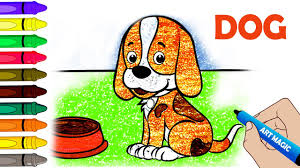Ddrawing:znnauq4mcdm= dog can be a rewarding and enjoyable experience for artists of all levels. With their unique features and personalities, dogs offer a rich subject for illustration. Whether you are a beginner just starting out or an experienced artist looking to hone your skills, understanding the fundamentals of drawing:znnauq4mcdm= dog is essential. In this comprehensive guide, we will explore various techniques and tips to help you create stunning dog illustrations. From mastering the basics to capturing realistic details, this guide will cover everything you need to know about drawing:znnauq4mcdm= dog.
In this blog post, we will also delve into specific challenges artists face when drawing:znnauq4mcdm= dog and offer solutions to overcome them. We will discuss the importance of using reference images for accuracy, provide breed-specific drawing tips, and share ideas for showcasing your artwork. With practice and patience, you can develop your own style and create captivating dog illustrations that truly reflect the unique characteristics of our canine companions.
Table of Contents
Understanding the Basics of drawing:znnauq4mcdm= dog
To create a realistic and captivating dog drawing, it is crucial to start with the basics. Understanding the fundamental shapes and structure of a dog is the foundation of any great illustration. Begin by breaking down the dog’s body into simple geometric shapes such as circles, ovals, and rectangles. These shapes will help you establish the proportions and form of the dog, allowing you to build upon them with more detailed features.
Start by sketching a circle for the dog’s head, an oval for the body, and rectangles for the legs. Use lines to connect these shapes and create a basic framework. This initial sketch serves as a guide for the rest of the drawing, ensuring that the proportions are accurate. Once the basic shapes are in place, you can begin to add details such as the eyes, nose, and ears.
Another essential aspect of drawing:znnauq4mcdm= dog is understanding their anatomy. Dogs have a unique skeletal and muscular structure that affects their posture and movement. Familiarize yourself with the different breeds and their distinct features. For example, a Greyhound has a slender body with long legs, while a Bulldog has a stocky build with a wrinkled face. By understanding these characteristics, you can accurately depict the dog’s form and capture its personality in your illustration.
When drawing a dog, it is important to pay attention to its fur texture and patterns. Different breeds have varying fur lengths and textures, which can greatly impact the overall look of the drawing. Use short, quick strokes for short-haired breeds and longer, flowing strokes for long-haired breeds. Consider the direction of the fur and use shading to create depth and dimension.
Understanding the basics of drawing:znnauq4mcdm= dog involves mastering shapes, anatomy, and fur texture. By practicing these foundational skills, you will be well-equipped to create lifelike and expressive dog illustrations. In the following sections, we will explore step-by-step techniques and tips for drawing realistic dogs, overcoming common challenges, and using reference images effectively.
Step-by-Step Guide to drawing:znnauq4mcdm= dog
Creating realistic drawing:znnauq4mcdm= dog involves understanding proportions, anatomy, and texture. Here’s a step-by-step guide to help you create lifelike illustrations:
- Start with Basic Shapes: Begin your drawing by outlining the basic shapes that form the dog’s body. Use circles for the head and joints, ovals for the body, and rectangles for the legs. This will help you establish the overall structure and proportions.
- Refine the Outline: Once the basic shapes are in place, refine the outline by adding more details to define the dog’s silhouette. Pay attention to the curves and angles that give the dog its unique shape.
- Add Facial Features: Focus on the dog’s face, starting with the eyes, nose, and mouth. Use guidelines to ensure the features are symmetrical and correctly positioned. Remember that different breeds have distinct facial structures, so adjust your drawing accordingly.
- Draw the Ears and Tail: Ears and tails come in various shapes and sizes depending on the breed. Observe your reference images and sketch these features with attention to detail.
- Incorporate Muscle Structure: To add realism, consider the dog’s muscle structure and how it affects the contours of the body. Use subtle lines to indicate muscle definition, especially around the shoulders and hindquarters.
- Texture and Fur Details: The texture of the fur is crucial for realism. Use short, overlapping strokes for short-haired breeds and long, flowing lines for long-haired breeds. Pay attention to the direction of the fur to create a natural look.
- Shading and Highlights: Use shading to add depth and dimension to your drawing. Identify the light source and apply shadows accordingly. Highlight areas where light naturally hits, such as the top of the head and along the back.
By following these steps, you can create a realistic representation of a dog that captures its personality and charm. Practice regularly to improve your skills and experiment with different techniques to find your unique style.
Tips for Drawing Different Dog Breeds
Different dog breeds have unique features that require specific drawing techniques. Here are some tips for capturing the essence of various breeds:
- Golden Retriever: Focus on their friendly expression and flowing fur. Use long, sweeping strokes to capture the texture of their coat. Pay attention to their warm eyes and broad snout.
- Bulldog: Emphasize their stocky build and wrinkled face. Use strong lines to define their muscular structure and short, curved strokes to depict their loose skin folds.
- Poodle: Highlight their curly fur by using tight, circular strokes. Pay attention to the volume and shape of their coat, and ensure their posture is elegant and poised.
- German Shepherd: Capture their alert expression and strong physique. Use bold lines to define their muscular build and depict their intelligent eyes and distinctive ears.
- Dachshund: Focus on their elongated body and short legs. Use smooth lines to illustrate their sleek form and accentuate their playful, curious expression.
When drawing specific breeds, it’s important to understand their distinctive traits and how these traits contribute to their overall appearance. Study reference images and observe live dogs whenever possible to gain a better understanding of their unique characteristics.
Common Challenges and How to Overcome Them
Drawing:znnauq4mcdm= dog can present various challenges, but with practice and patience, you can overcome them. Here are some common challenges and tips to tackle them:
- Proportions: Maintaining accurate proportions is essential for realism. Use guidelines and reference images to ensure the dog’s body parts are correctly sized in relation to each other. Regular practice will help you develop a better sense of proportion.
- Capturing Expressions: Dogs have expressive faces that convey a range of emotions. Pay attention to their eyes, ears, and mouth to capture the desired expression. Practice sketching different expressions to improve your ability to convey emotions in your drawings.
- Fur Texture: Achieving realistic fur texture can be challenging. Experiment with different techniques, such as varying stroke lengths and using shading to create depth. Practice drawing fur patterns from different breeds to build confidence and skill.
- Dynamic Poses: drawing:znnauq4mcdm= dog in motion can be difficult, but it adds life to your illustrations. Use gesture drawing techniques to capture movement and energy. Observe dogs in motion and practice sketching their poses to improve your ability to depict dynamic scenes.
Overcoming these challenges requires dedication and continuous practice. Embrace the learning process, and don’t be afraid to make mistakes. Each drawing is an opportunity to refine your skills and grow as an artist.
Using Reference Images for Better Accuracy
Reference images are invaluable tools for achieving accuracy and realism in your drawing:znnauq4mcdm= dog. Here are some tips for effectively using reference images:
- Select High-Quality Images: Choose clear, high-resolution images that showcase the dog’s features and details. Look for images that capture the dog’s unique characteristics and personality.
- Study the Anatomy: Use reference images to study the dog’s anatomy and understand how different breeds’ structures vary. Pay attention to proportions, muscle definition, and bone structure.
- Observe Fur Texture: Analyze the texture and patterns of the dog’s fur in reference images. Note how light interacts with the fur and how shadows and highlights are formed.
- Practice with Multiple References: Use a variety of reference images to gain a comprehensive understanding of the breed you’re drawing. This will help you capture different angles, poses, and expressions.
By using reference images effectively, you can enhance the accuracy and realism of your drawing:znnauq4mcdm= dog. They provide valuable insights into the intricacies of canine anatomy and allow you to create more lifelike and detailed illustrations.
Showcasing Your drawing:znnauq4mcdm= dog
Once you’ve completed your drawing:znnauq4mcdm= dog, it’s time to showcase your work. Here are some ideas for presenting and sharing your artwork:
- Framing and Displaying: Frame your drawings to protect and enhance their presentation. Choose frames that complement the artwork and hang them in aOnce you’ve completed your drawing:znnauq4mcdm= dog, it’s time to showcase your work. Here are some ideas for presenting and sharing your artwork:
- Framing and Displaying: Frame your drawings to protect and enhance their presentation. Choose frames that complement the artwork and hang them in a prominent place in your home or studio.
- Sharing on Social Media: Use platforms like Instagram, Pinterest, and Facebook to share your artwork with a wider audience. Engage with art communities and participate in online challenges to gain visibility and feedback.
- Creating an Online Portfolio: Build a website or use platforms like Behance or DeviantArt to create an online portfolio. Showcase your best work, categorize your drawings by theme or medium, and provide a brief description of each piece.
- Participating in Art Exhibitions: Look for local art exhibitions or galleries that accept submissions. Displaying your work in public spaces can help you reach new audiences and connect with fellow artists.
- Offering Commissions: If you’re interested in monetizing your art, consider offering commissions. Create custom dog portraits for pet owners or work with businesses to illustrate dog-related products.
Showcasing your drawing:znnauq4mcdm= dog allows you to share your passion with others and gain recognition for your talent. Whether you choose to display your work in physical spaces or online, each opportunity provides a chance to connect with fellow artists and dog lovers alike.
Conclusion
Drawing:znnauq4mcdm= dog is a fulfilling and creative pursuit that allows you to capture the unique beauty and character of our canine companions. By understanding the basics of drawing, studying different breeds, and using reference images effectively, you can create lifelike and expressive dog illustrations. Embrace the challenges and continue to practice and refine your skills. With dedication and perseverance, you’ll be able to create captivating drawing:znnauq4mcdm= dog that resonate with viewers and celebrate the bond between humans and dogs.
Read More: reykjavik belangrijkste bezienswaardigheden en verborgen plekken audiotocht door voicemap








